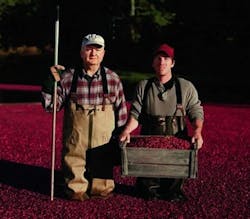Cranberries sorted by vision system
One of the largest growers supplying Ocean Spray with cranberries has installed a vision-based sorting machine from Key Technology (Walla Walla, WA, USA).
L&S Cranberry (Quebec, Canada) farms and packs eight million pounds of fresh cranberries a year, on average, during its four-month season. To achieve these goals, the company uses Key Technology's Optyx 6000 series sorter.
The Optyx sorter can inspect up to 12,000 pounds of fresh cranberries per hour. The system detects each object's size, shape, and color, and the difference in the objects' structural properties, enabling it to identify and remove foreign material, defects and soft berries called "poppers" that spoil quickly and affect other berries in a bag.
The system was installed in 2008, when the company decided that it had grown large enough to justify having its own packing plant. The Optyx sorter was installed after personnel at L&S Cranberry had seen how effective it had been at Ocean Spray.
Last year, the company ramped up production from one shift per day to two shifts per day, six days per week. When it did, Key Technology’s RemoteMD tool was added to allow the engineers at the plant to monitor and perform diagnostics on the sorter remotely.
Vision systems are being put to a variety of uses in the agricultural industry. Here are ten of the top stories on the subject that Vision Systems Design has recently published on the subject.
1. iPhone app helps farmers manage fruit pickers
A new iPhone app called BucketLoad aims to help farmers manage teams of individuals who hand-pick crops such as blueberries, strawberries and citrus fruit during the harvest season.
2. Vision software blends into food processing
To increase the quality of their products while reducing waste and manual labor costs, manufacturers in agricultural and packaging industries are leveraging machine-vision systems.
3. Automated system inspects dates at high speed
Com-N-Sense has teamed up with Lugo Engineering (Talme Yaffe, Israel) to develop a system capable of automatic sorting of dates.
4. Vision system helps sort carrots
Food sorting system manufacturer Odenberg (Dublin, Ireland) has developed a vision-based machine that can sort fruit and vegetables.
5. Machine-vision-based inspector sorts oranges and mandarins
Scientists at the Valencian Institute of Agrarian Research (IVIA; Valencia, Spain) have created an optical inspection device that detects and separates rotten oranges, a second device that classifies mandarin-orange segments according to their quality, and a third that assists citrus-fruit pickers in the field.
6. Potato industry reaps benefits of computer vision
A prototype computer vision system that can identify sub-standard potatoes has been developed by computer scientists from the University of Lincoln (Lincoln, UK).
7. Spectral Imaging Sorts 'Sugar-End' Defects
EVK and Insort have developed a system to automate the task of potato inspection while reducing waste.
8. Vision system sorts tomato seedlings
A system developed at Wageningen UR–Food and Biobased Research (Wageningen, the Netherlands) is capable of sorting tomato seedlings at a rate of 18,000/hr.
9. Linescan-based system counts seeds
Coleman Technologies Inc. (CTI; Newtown Square, PA, USA) has developed a linescan-based imaging system that counts seeds at high speeds.
10. Cherry tomatoes sorted by vision
Korean researchers have developed a system to examine the feasibility of sorting cherry tomatoes based on real-time color image processing.
-- Dave Wilson, Senior Editor, Vision Systems Design
